
| site search by freefind | advanced |
AERO VINTAGE BOOKS
2004 B-17 NEWS
Back to B-17 Information
Back to the Main Page
B-17 News Archive
2018 B-17 News
2017 B-17 News
2016 B-17 News
2015 B-17 News
2014 B-17 News
2013 B-17 News
2012 B-17 News
2011 B-17 News
2010 B-17 News
2009 B-17 News
2008 B-17 News
2007 B-17 News
2006 B-17 News
2005 B-17 News
2004 B-17 News
2003 B-17 News
2002 B-17 News
1997-2001 B-17 News
December 2004
- Wednesday, December 8th was the day. Culminating a restoration effort that began in 1992, and after a 37 year absence from the skies, 44-85734 (N390TH) spread its wings once again and flew on the afternoon of the 8th from Kissimmee, Florida.
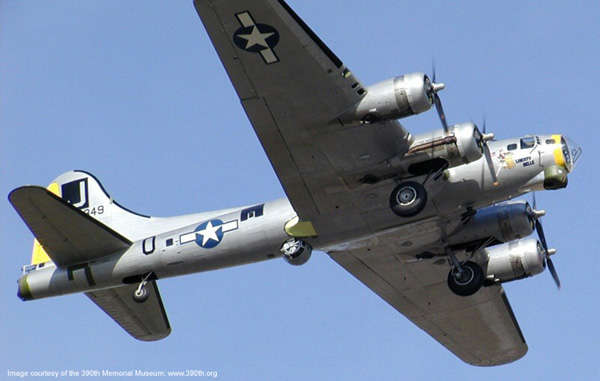
An attempt was made on the 7th, but a magneto problem with the #1 engine surfaced during engine runs, but that was quickly corrected and the B-17G made a short flight the following day. The airplane will be operated by the Liberty Foundation as a commemoration to veterans. The Liberty Foundation was organized by Don Brooks of Atlanta, Georgia, whose father flew with the 390th Bomb Group from Framlingham, England while assigned to the Eighth Air Force. The airplane is painted as the Liberty Belle, a 390th B-17G that carried the serial of 42-97849. During a combat mission, it reportedly force landed in February 1945 and was then salvaged. It is the second B-17 painted in 390th colors, the other being on display at the 390th Memorial Museum in Tucson, Arizona.
Speaking of salvage, that's pretty much all this airframe was back in 1990 when Tom Reilly acquired it from the New England Air Museum. It had been nearly destroyed by a tornado in 1979 while on display at the museum at Bradley Airport in Connecticut. The wreckage was traded to Reilly for work his company did for the museum on a B-25H. This B-17 was one of the two radically modified engine test beds created by Boeing in 1946, one for Pratt & Whitney and the other for the AAF. The AAF airplane, 44-85813, was lent to Curtiss-Wright, so both the big U.S. engine manufacturers were operating B-17s capable of mounting large radial (and later turboprop) engines on the forward fuselage. The modifications done by Boeing involved moving the cockpit aft several feet and beefing up the fuselage structure, including the use of thicker aluminum for the skin. Thus, Reilly's task was not only to rebuild the airplane from wreckage, but also to put it back as Boeing intended, requiring much fuselage work and the construction of a conventional B-17G nose section. Two new owners, tens of thousands of man hours, and millions of dollars later, and out pops Liberty Belle. Piece of cake. Actualy, this is surely the most difficult B-17 restoration to airworthy condition undertaken to date.
A few details of interest bandied about. The unique two piece windshields installed during the restoration were replaced with the more common one-piece parts in the week before the flight. The two piece windshields were installed on many B-17s during the war, with a small panel that could be opened by the pilot to either clear the main windhield of ice, or to allow a view outside for landing if the main windshield was obscured. Kind of like the Air Corps just couldn't quite trust an airplane that couldn't be open cockpit just a little bit if needed. The C-47 had the same arrangement. But the glass is vision obscuring, and someone (this is not confirmed by anyone...I'm just making it up) probably thought about the hundreds of airplanes flying around Kissimmee and decided the best possible view outside was warranted. Also, the airplane is to be repainted. It was painted after the major assemblies had been reinstalled, but the year-plus effort at finishing the restoration has left alot of panels unpainted or primed only, and the airplane will be refinished to complete the restoration.
I'm standing by for some details about the days leading up to the first flight, and the flight itself, so check back as I'll post when more information becomes available. I suppose that since I am trying to sell books through all this effort, something that I occassionally forget, I really should mention that Final Cut has a section about this airplane providing many details and photos of its history. Not only this airplane, but all of the surviving B-17s, a 216 page valuable resource to those afflicted with the B-17 bug.
A hearty congratulations is extended to Tom Reilly as this has pretty much been his baby all along. Not always his money, but certainly his vision for this airplane is what brought it back to life. His wife Suzzie, and the crew of craftsmen he assembled, should also be thanked by the warbird community for bring one more B-17 back from the verge of obliteration. We welcome the opportunity to see the airplane up close and flying. Look for it next year on the circuit.
- Other good news is that the work to put 44-83872 (N7227C) back in the air is moving right along. This B-17G, operating as Texas Raiders by the CAF, has been grounded for several years for maintenance and a costly Airworthiness Directive enforced by the FAA on B-17s. The airplane was moved in early December to a new worksite. Check out this link to see what is going on. Hopefully, this airplane will be flying in 2005 and bring the total of operating B-17s up to 14. By the way, this airplane is an ex-Navy PB-1W and was the the first genuine B-17 warbird a-way back in 1967. Oh, right, the complete story of this airplane can also be found in Final Cut. (Remember, Christmas is coming and this book would make a great stocking stuffer for your wife. My wife heartily recommends this book, or would if she knew I was writing this.)
November 2004
- Some photos have surfaced about the B-17G that was surfaced. The Dyke Lake B-17G, 44-83790, which had been underwater in a Labrador lake since the spring of 1948, was floated and recovered by a team led by Don Brooks and Underwater Admiralty Services this past August. The airplane was then disassembled and transported from Labrador to the Brooks facility near Atlanta, Georgia. The condition of the airplane will be assessed to determine if it can be restored to airworthy condition. There are many updates about this airplane in the text below, going back to September 1998. One photo, shown here, depicts the airplane shortly after it was resurfaced.
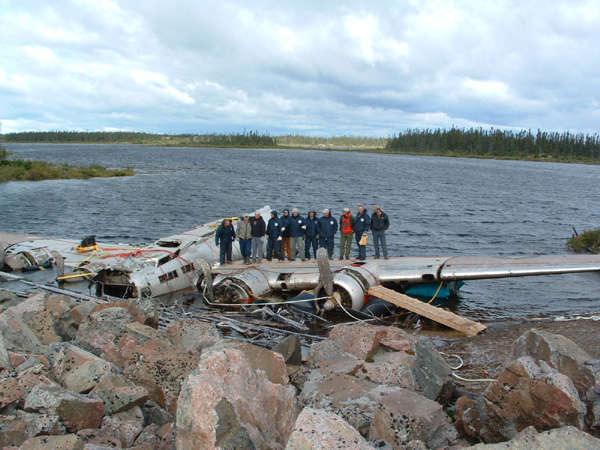
Of particular note is that the cockpit section has been flattened down into the fuselage. Also, the aft fuselage and the nose section are missing. How the cockpit got damaged while it was underwater is a big question. The airplane was eventually towed in the water some 68 miles to the nearest road. It was pressure washed at the lakeside to remove some of the layers of growth on the airframe, then disassembled. Later, Gary and Debbie of Labrador photoraphed the airplane after it was loaded aboard trucks for transport to Georgia. Here is one of the photos:
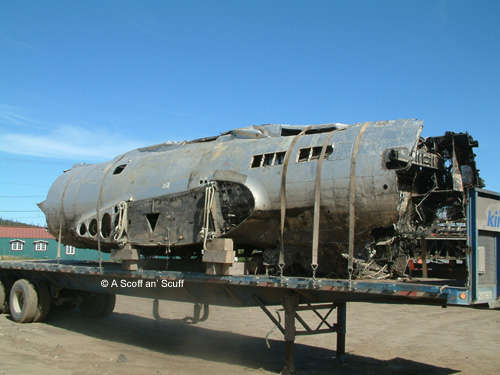
If you want to see more, jump here, or, better yet, jump to the A Scoff an' Scuff website where Gary and Debbie have posted many photos of the airplane both in Labrador City and while being transported through Montreal, Quebec. Also online are some great photos and much information about the recovery on a Brooks Aviation/UAS website. Some good stuff out there. Check it out! (Thanks to Todd Hackbarth and Gary and Debbie for information.)
- For whom the Belle tolls? It may toll for Memphis yet. In an unexpected move, the USAF Museum has now granted the city of Memphis an extension see if they can get their act together on the plans for 41-24485. The Air Force has imposed a "strategic pause," a military term that apparently means that many Congressional representatives and Senators have asked the USAF to re-examine its decision. The Air Force issued a letter to the Memphis Belle Memorial Association on October 20, meaning a decision should be in by Christmas. Will it be coal or a B-17F for Memphis? Keep informed by checking out the Memphis Belle Memorial Association's website.
- A bit of older news, but overlooked last time around. Inventor Robert E. Fulton passed away at the age of 95 in late May. For B-17 guys, Fulton is known for the development of the Fulton Sky Hook that was mounted on the Intermountain Aviation B-17G, 44-83785 (N809Z) back in the early 1960s. It was used to recover men off the ground using a helium-filled balloon and was featured in the James Bond film Thunderball. He contributed a number of other significant inventions to aviation and other industries.
- Patrick Carry passed along a photo of B-17G 44-83542 taken at Kermit Weeks' Fantasy of Flight in July 2004. The airplane is hard to photograph because it is packed in tightly with other exhibits. The airplane was pieced together from the wreckage of an air tanker and though it looks pretty good, is nowhere near airworthy or complete.
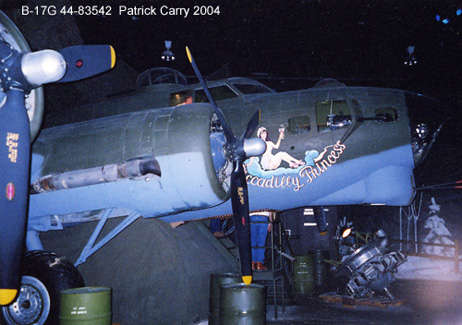
- Bill Stanczak provided this photo of the aft fuselage of B-17E 41-2595 as it is slowly coming together. This B-17E, modified to become the XC-108, had a large cargo door installed in the left fuselage. The cargo door is out and the stringers and formers are going into place to rebuild the fuselage as a standard B-17E. The group, headed by Michael Kellner, is slogging its way slowly but surely toward putting this B-17, known as the Desert Rat, back together again.
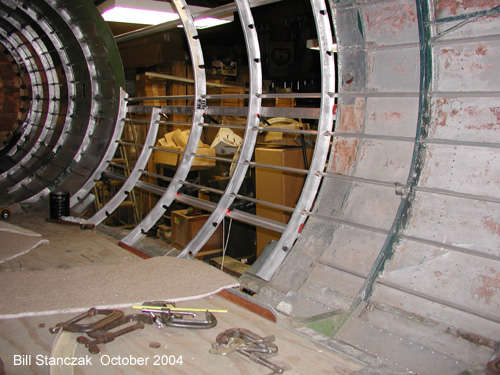
October 13, 2004 Update!!
- Tragic news from Michigan. The Yankee Air Force hangar and much of the museum collection was completely destroyed by a hangar fire on Saturday, October 9. The YAF B-17G, 44-85829 (N3193G), which was inside the hangar when the fire started, was saved by the museum staff. Here is the text of an updated press release issued by the museum:
"The Yankee Air Museum at Willow Run Airport suffered a disastrous fire saturday night that destroyed the historic hangar that housed the museum. The museum staff was able to move the historic B-17, C-47 and B-25 aircraft out of the building, thus saving the heart of the collection. In addition, all the historic aircraft on display outside of the main building were untouched by the fire. While many irreplaceable artifacts, photos and books were lost in the fire, the Volunteers at the museum are thankful that the aircraft collection remains largely intact. Only a small number of non-flyable aircraft that were in restoration inside the hangar were lost.
The Yankee Air Museum members, staff and volunteers are determined to rebuild the museum facilities and continue the great work that was begun in 1981 by a small group of visionaries who were dedicated to preserving this important piece of aviation and Southeastern Michigan history.
The Michigan Aerospace Foundation, the sister organization of the museum which was formed to plan and fund future expansion of the museum facilities, will now be working hard to raise the necessary funds to re-build the museum as soon as possible. Working with Willow Run Airport and the Yankee Air Museum, the Foundation will be seeking funding and other help from Foundations, Corporations and Individuals as it works to replace what has been lost
The Yankee Air Museum and the Michigan Aerospace Foundation would like to ask that anyone with an interest in helping to rebuild the museum, please contact the Foundation. Also, anyone who has artifacts they would be willing to donate to the museum should contact the Curator, Gayle Roberts."More information may be available here.
- In other B-17 News, one of the best known B-17s, B-17F 41-24485, the Memphis Belle, has finally been transferred back to the USAF Museum. Held by the city of Memphis since 1946, the airplane has had its ups and downs. Evidently, the USAF Museum was tired of the downs, and as they ultimately owned the airplane, they have exercised an option in the loan agreement and the airplane will now be going to Dayton for restoration and display. Here is part of the text in the USAF press release:
"Memphis Belle to find new home at Air Force's national museum
WASHINGTON, D.C. - Air Force officials announced plans to relocate the World War II B-17 "Memphis Belle" to the National Museum of the U.S. Air Force near Dayton, Ohio today. No date has been set, but the move is expected to occur before the end of the year in conjunction with activities planned to observe the 60th anniversary of the end of World War II.
"We are grateful to the Memphis Belle Memorial Association for its preservation and restoration of the Memphis Belle," said Maj. Gen. (Ret) Charles Metcalf, director of the NMUSAF. "We have enjoyed the partnership over the years and look forward to the continued collaboration as we make this transition," he added. The aircraft has been located in the Memphis, Tenn. area since 1946. It was on loan from the Air Force to volunteers and aviation enthusiasts until the 1980's when the MBMA became its leaseholder. "The Memphis Belle is a prominent and famous part of the Air Force's historic collection," said Mr. Dick Anderegg, director of Air Force history. "As such, it is only appropriate that it be displayed at the service's national museum where it can be viewed by millions and exhibited in a manner consistent with its proud legacy." The museum's restoration team, which maintains all of the nearly 350 aircraft and aerospace vehicles in the museum's collection, will continue the restoration on-site. The effort will begin immediately upon the aircraft's arrival and is expected to take several years to complete. Museum officials plan to exhibit the aircraft as the centerpiece of its considerable WWII aircraft collection once restoration is complete. "We will give it a level of care and public visibility befitting its legacy to ensure its continued preservation for future generations to learn about the heroism and bravery of its crew," said Gen Metcalf. The Memphis Belle is a national and cultural icon with a name recognition comparable to that of the B-29 Enola Gay on display at the Smithsonian National Air and Space Museum."There is also a response from the Memphis Belle Memorial Association at their website that is worth reading. Also at that site is a copy of the letter sent by the USAF to the Association, reproduced here:
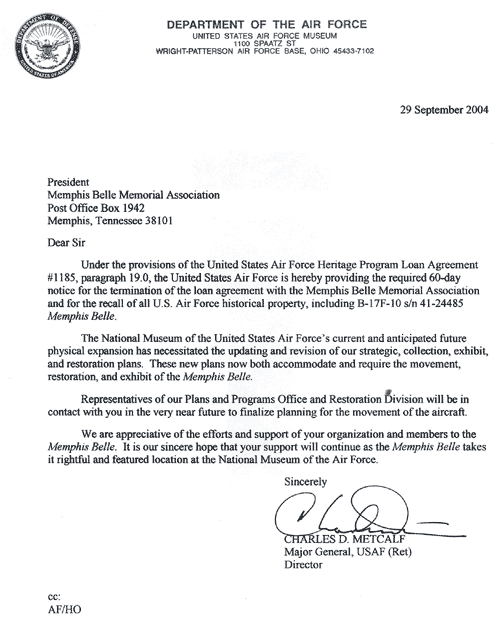
What this means to the display status of Shoo Shoo Baby in five or ten years when the restoration of the Belle is completed has not been announced.
September 2004 Update!!
- Rumor #1: An EAA crew will arrive at Van Nuys on Monday, September 20, to prepare EAA B-17G 44-85740 (N5017N), Aluminum Overcast (though more of an aluminum undercast since it's May 2004 belly landing) for a ferry flight to Oshkosh, scheduled departure on Wednesday, September 22.
- Rumor #2: The remaining B-17 parts cache owned by Tom Reilly, consisting primarily of the remains of SB-17G 44-83722 and B-17G 44-85813 (N6694C) has been sold to a Canadian group for the basis for a long term restoration project.
- Rumor #3: The recently raised Dyke Lake B-17G, 44-83790, is temporarily stored at Labrador City in the Provice of Newfoundland and Labrador, and is awaiting air transport to Georgia or, presumably, Kissimmee. This assumes the title issues have been worked out, and I am not convinced they are. By the way, look at the video of this B-17G underwater and then consider the assessment that this airplane is in excellent condtion.
The rumor mill grinds on....
September 2004
- A most significant B-17 event occurred during the last week of August with the long-awaited recovery of B-17G 44-83790 from Dyke Lake in the Canadian wilderness of Labrador. The B-17G made an emergency wheels-up landing on the remote frozen lake on December 24, 1947. The crew and passengers, numbering nine, were rescued a few days later, but the airplane was abandoned. In the spring thaw of 1948 the B-17 broke through the ice and settled to the bottom of the lake, largely forgotten until the late 1980s. At that time Tom Wilson, who once worked for the Military Aircraft Restoration Corp. at Chino, set out to locate the airplane. He was able to attact the attention of Don Brooks who eventually took on the sponsorship of the effort. The airplane was finally located in the lake in 1999 but became the subject of lawsuits after the Province of Newfoundland and Labrador laid claim to ownership of the underwater wreckage. Finally, in May of this year, the Federal Court of Canada allowed the B-17 to be recovered, with direction on how the ownership dispute would be resolved.
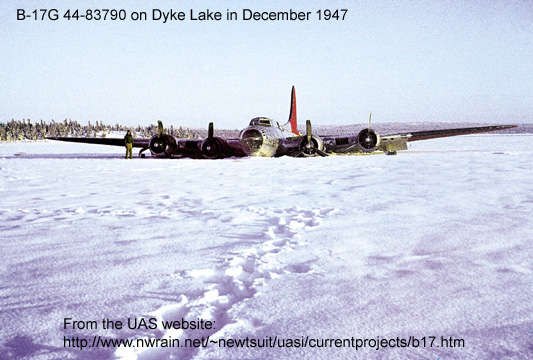
The go-ahead allowed Underwater Admiralty Services (UAS) of Washington, under a contract with Brooks, to refloat the airplane and remove it from the lake. As noted, this occurred during the last week of August. The company reportedly used eight salvage gags placed under the airplane that were then filled with air, allowing the airplane (weighing an estimated 32,000 pounds) to return to the surface. It was then "power-washed" to remove "marine growth." According to documents located at the UAS website, the airframe will now be turned over to the Canadian Receiver of Wrecks and the Province of Newfoundland and Labrador will be afforded the opportunity to make a claim of ownership. If the Province so claims ownership, a salvage fee will be negotiated and paid to Brooks. It is hoped and expected that the Province will not make a claim, and the airplane can be brought back to the U.S. for restoration. Brooks has stated that the airplane will return to the air, with one source claiming that only a three-year effort will be necessary.
Brooks has entered the world of B-17 ownership in a big way, as his foundation is also the owner of B-17G 44-85734, which is nearing airworthy condition after a fifteen year restoration effort. (See below.) We eagerly await photos of the Dyke Lake B-17 recovery effort, and to see the plans come together toward an eventual restoration. Look here for more general information on this B-17G from the UAS website.
As an aside, this airplane has been referred to as an "SB-17G" in numerous legal and media accounts, though the USAF record card does not indicate it was ever anything more than a "B-17G". It was built by Douglas and accepted for service on June 11, 1945, at Long Beach. It was stored for a year at Lubbock, Texas, before being activated in September 1946 and assigned to a base in Greenland. On the day it crashed, it was on an adminstrative trip from Greenland to Goose Bay with a crew of seven, two passengers, and two bodies in transit as part of the cargo.
- As noted above, the other Don Brooks B-17G, 44-85734 (N390TH), is very close to flight status. Here are two photos, one taken in 1989 and one taken by Chuck Gardner on August 18, 2004, as the finishing touches are being applied:
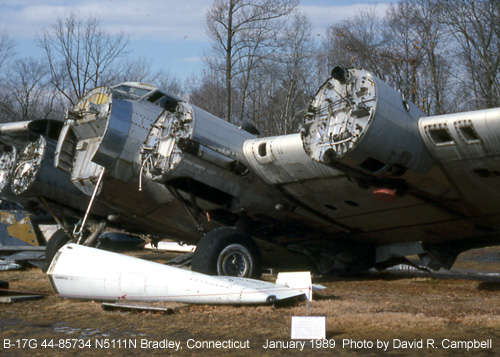

This has been an amazing story from start to finish, as this B-17 was heavily modified by Boeing for use as a test bed, and then was nearly destroyed by a tornado in 1979. It has been under rebuild at Tom Reilly's facility at Kissimmee, Florida, since the early 1990s, a massive effort given the condition of the received airplane. No firm date has been announced for the first flight, but the pilots for that effort have been selected so it is getting close.
- More on the buried B-17 somewhere under Hurlburt Field, Florida. This comes from Pete Larson regarding the original story and photos sent in by Mark Sublette. Pete reports a memory:
"...I was stationed at n Field from 1967 until my discharge in 1969. I lived near Hurlburt for one year after my discharge. I was riding an off-road motorcycle near the eastern edge of Hurlburt during the Spring of 1970 when I came across the remais of the B-17 you mentioned in this article (B-17 News, July 2000). I regret that I did not take a picture of the mortal remains of this once great aircraft for you to publish. Someone somewhere must know what caused this B-17 to end up in the dump at Hurlburt. I always assumed it must have been involved in an accident with damage too great for repairs..."
And the questions remain...but the information is welcomed and adds a bit more to the story of this buried B-17.
- Monte Hendricks passed along information that the continuing investigation into the destruction of the wing structure of the sole remaining B-17C is ongoing by the U.S. Forest Service. This B-17C, 40-2047, crashed in November 1941 in a remote area northeast of Placerville. As reported in prior items, this B-17 wreckage was vandalized for wing parts several years ago but Monte reports the investigation remains open, and that the Forest Service requests that the site be left alone.
- An FAA Brief Report has been published by the FAA regarding the gear-up landing of B-17G 44-85740 (N5017N) on May 6 at Van Nuys airport. It is available for viewing here, and it describes the incident and damage in some detail. The report repeats the EAA statement that the gear was not down and locked at the time of the incident, presumably meaning the roll out phase of the landing when the collapse occurred. The EAA website is quiet about the current status of the airplane which reportedly remains at Van Nuys as repairs are completed to allow a ferry flight back to Oshkosh.
July 2004
- After the comments made in the March 2004 update regarding Texas Raiders, the CAF B-17G based at Houston, Texas, CAF Col. Neil McNeight advised me via email the current situation with 44-83872 (N7227C). In March, we reported that "It should also be noted that for all practical purposes, 44-83872 (N7227C), operated by the CAF as Texas Raiders is really in indefinite storage pending the eventual repair (we hope) of the wing structure so it can fly again. All it takes is money, and there isn't enough to get the airplane repaired. Thus, the scoreboard right now shows twelve B-17s operational or trying to be."
Neil reports that there actually is enough money to repair the airplanes. He reports that "...while flying warbirds, though it often seems that there is really never enough money, that is where volunteers make the difference. While I won't go into specifics in this e-mail, our members have been working very hard to not only put "TR" back in the air, but bring her back better than before. From overhauling the cowl flaps and performing scheduled maintenance on the engines, to refurbishing the Norden bomb sight, to restoring support equipment such as our tug and propeller trailer, and even improving the facilities where we work, our members have consistently answered the call for support. For these reasons, and many others, Gulf Coast Wing was awarded the Distinguished Unit Award for 2003 by CAF Headquarters."
Neil went on to report that "..with respect to our progress on the wing spar AD, the new terminal ends are in the process of being finished as I type. We even have pictures of the parts in the rough (coming soon to the website). Once these parts are complete, they will be fitted to the aircraft ASAP. We also have a hard deadline of getting 'TR' back in one piece and moving again by the first of November, as the City of Houston will be bulldozing the area of Hobby Airport where 'TR' is currently parked." That's an incentive. Neil asks that we keep an eye on the wings website located here, as it will be updated regularly. He notes the 'plane truth' of the situation: if readers "...truly enjoy watching B-17's fly, that they should consider donating either their time or their money towards the organization and B-17 of their choice. We love making people happy, and we know that there are a lot of well-wishers out there, but the unfortunate truth is that airplanes don't fly on moral support alone."
Well said, and we hope to see the airplane back in the air soon.
- The registered owner of B-17E 41-9210 (N12355) was changed from the Flying Heritage Collection to Vulcan Warbirds, c/o Joe Franzi of Seattle, Washington, on May 12, 2004. This appears to be just gathering the collection under one umbrella company, as most of the collection owned by Paul Allen has been so re-registered. The airplane remains under a gradual restoration at Arlington, Washington.
- EAA Update: posted on the EAA website is this announcement:
"July 1, 2004 - EAA's 2004 Salute to Veterans B-17 Tour resumes in a big way less than a month from now at EAA AirVenture Oshkosh 2004. There is still a good quantity of seats available, so now may be the best time to reserve yours and fly an actual B-17 mission aboard Fuddy Duddy. This airplane, on loan from the Wings of Eagles Discovery Center (formerly the National Warplane Museum) of Elmira, New York, takes the place of EAA's B-17 Aluminum Overcast, which was damaged in a May 5 gear collapse in Southern California. Once Fuddy Duddy completes its AirVenture mission, it will head out to resume the postponed tour with 28 stops scheduled from August 6 through November 21 beginning in Waukesha, Wisconsin.
Having arrived earlier in June, required inspection work on Fuddy Duddy is reportedly 80 percent complete at this writing. Meanwhile, work continues on Aluminum Overcast in SoCal in preparation for its special ferrying flight back to Oshkosh just in time for the convention. Once here, Aluminum Overcast will be on display on AeroShell Square and provide an opportunity for people to take ground tours and make a donation toward its full restoration. As of the end of June, two of the engines and propellers are installed and significant progress continues on the aircraft's sheet metal work."
May 2004 Update #3: EAA B-17G
- With regard to the EAA B-17G gear up landing at Van Nuys, California, on May 5, the EAA released information on May 12 that noted a video has been obtained by the EAA that "shows the entire incident from approach to touchdown, rollout, and gear collapse."
The EAA Museum Director, Adam Smith, stated: "The video shows the whole landing sequence in great detail. As had been reported by the crew, the airplane executes a normal approach and the touchdown is very smooth. As the landing roll out is completed, the tailwheel is unlocked and a severe shimmy is evident right away. A couple of seconds later, just as the airplane is beginning its turn to texit the runway, the right main undercarriage collapses followed almost immediately by the left."
The press release goes on to state that "close scrutiny of the tape indicates that the gear was not 100 percent fully extended on both sides." Smith stated: "On at least one side the downward travel of the gear appears to have stopped slightly short of the normal position."
The EAA now have a "reasonably good idea" of the repairs that will be needed on Aluminum Overcast, and the organization is working out the best way to go about making them. No timeline has been set for completion of the aircraft inspection or ensuing repairs. The full text of the release can be found here.
May 2004 Update #2...Bad News!
- A significant incident occurred on Wednesday afternoon, May 5, 2004, for the EAA B-17G, Aluminum Overcast. It had just landed on Runway 16 Right at Van Nuys and was rolling out about to turn off the runway when both main landing gears collapsed. The bomber dropped onto its belly, immediately stopping all four engines and driving the ball turret mounting structure through the roof of the fuselage just aft of radio compartment. The cause of the collapse has yet to be determined.
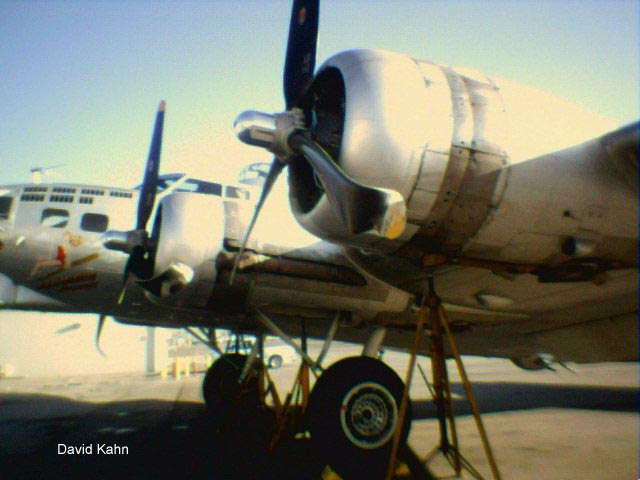
The EAA B-17G, 44-85740 (N5017N), was in the midst of a Salute to Veterans tour through the west when the 4:26 P.M. incident occurred. The initial FAA brief indicated one crewmember (?) and 5 passengers aboard at the time. Another report stated that one of the donors of the B-17 to the EAA, Bill Harrison, and Al Malecha were at the controls with two EAA mechanics also on board. The airplane was reportedly being ferried in from Edwards AFB. There was at least one helicopter news crew that photographed the accident, the report of which can be viewed here for as long as KCBS keeps the link alive. Not exactly the Zapruder film, but interesting nonetheless.
Within a few hours, the B-17 was jacked up and the main landing gears extended. Presumably, with the gear mechanically locked down, the airplane was moved to a hangar on the field where it could be inspected by the EAA for the planned repairs. Viewing photos of the airframe, it would be expected that all four engines will require detailed teardowns and inspections, and probably replacements. The four prop hubs will require the same, and nine of the twelve propeller blades will need to be replaced. Skin damage seems minimal to the fuselage, except where the ball turret structure came though the top of the fuselage. There was also some noticed wrinkling around some nacelles and near the wing-fuselage joint. What internal damage and/or structural damage resulted from the ball turret will probably determine how long the airplane will remain grounded. Reports also suggest that at least one of the nacelles was 'tweaked' and there may have been other damage. At a minimum, and educated guess would see at least $200,000 worth of damage based upon what a Wright R-1820 and the propellers cost. David Kahn took some detailed photos of the airplane parked on a Van Nuys ramp, some of which are included here. For the complete set of photos, check this out.
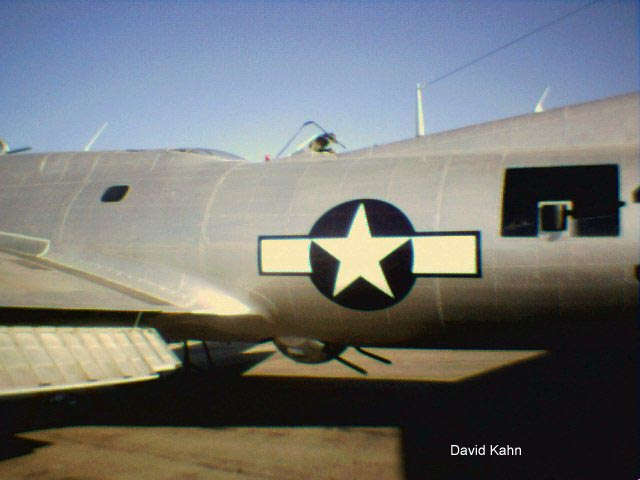
The main landing gear on the B-17G utilizes a retracting screw assembly that is electrically driven by a landing gear motor mounted forward in the nacelle. The retracting screw is attached to a drag strut that is, in turn, attached to the landing gear strut with the wheel and tire assembly. When the gear is fully extended, the retracting screw is fully extended and holds the landing gear down primarily through the rigidity of the retracting screw. When the gear is selected up, three electric motors (one for each main and the tail wheel) turn the retracting screws, shortening them. The action of screw shortening pulls the drag strut and landing gear strut forward and upward into the nacelle opening. Limit switches are mounted for fully retracted and fully extended to electrically stop the motor once the up or down position is reached. There is no other positive lock for the landing gear other than the retracting screw, although the drag strut appears to be in an overcenter position when the gear is extended to assist in holding the gear in a locked position. From an examination of the AAF technical order, there does not appear to be any air-ground switch in the circuit that would require weight-off-wheels to allow the landing gear motors to energize, something that is common on modern aircraft. Whether or not there were any modifications to the EAA's B-17 that would provide some sort of weight-on-wheels switch to prevent inadvertent gear retraction is unknown.
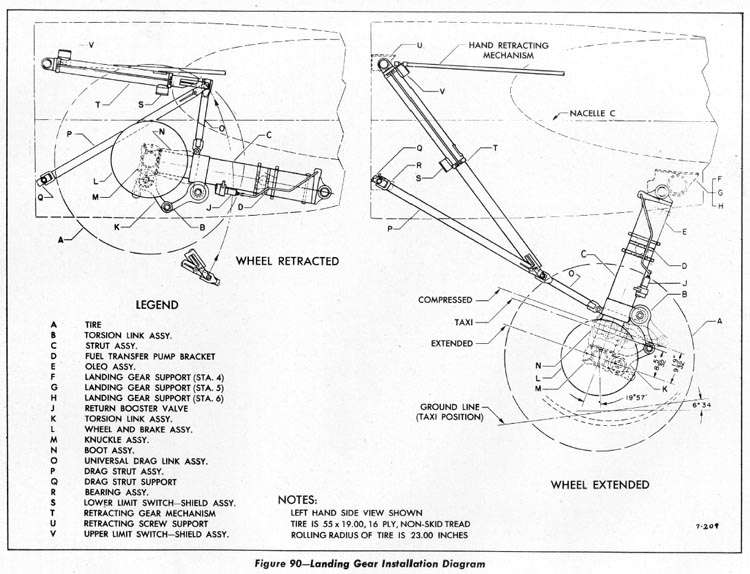
The landing gear is controlled by a small toggle switch located on the center pedestal, two switches away from the flap switch. On the standard B-17G pedestal they are somewhat protected by small metal guards alongside each switch. In the diagram below, item 5 is the landing gear switch and item 6 is the flap switch. Any modifications to the EAA cockpit setup are not known.
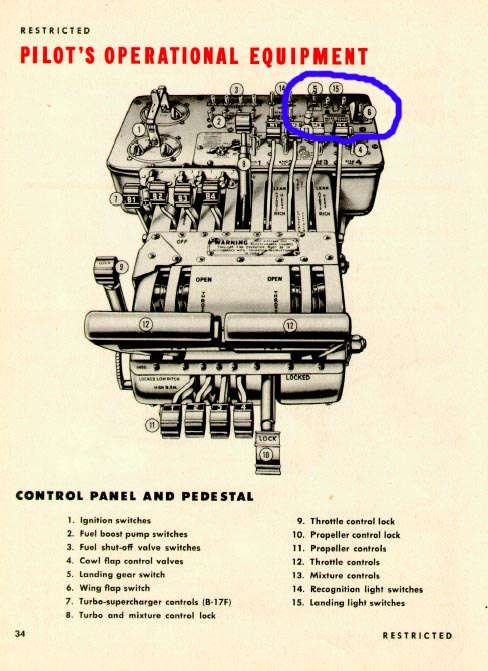
Notable about the EAA airplane is that the tail wheel was evidently rigged not to retract, as indicated by recent airborne photos of the B-17, and in the incident the tail wheel indeed remained extended. Something that is noticable on the available video is that the tail wheel was shimmying as the B-17G was slowing to exit the runway, although there would not seem to be any direct correlation between that and the gear collapse. In some aircraft, a tail wheel shimmy can be lessened by increasing the weight on the tail and getting the airplane slowed down. One technique to get more weight on the wheels for braking is to retract the wing flaps to dump any remaining wing lift.
After the airplane was jacked up, the retracting screws on both main gear assemblies were found broken. Whether they broke and caused the incident or whether they broke as a result of the incident remains to be determined. Metal fatigue has been suggested, though the airplane appears to settle evenly on the runway and the likelihood of both retracting screws failing at exactly the same time seems unlikely. Speculation and misinformation is already spreading, but the video certainly speaks for itself. Because there were no injuries and the damage is considered minor, this is not really considered an accident but rather an incident. The NTSB will no doubt investigate and eventually make a report. It is hoped that the resources can be quickly marshalled to get this airplane back into the air.
- As long as we are updating the B-17 information, we heard from Blake Palmer, one of the Lone Star Flight Museum volunteers who wanted to correct some information reported below about the Lone Star B-17G,44-85718 (N900RW), flying as Thunderbird. Due to an unclear press release, it was widely reported that the interior work on the B-17G was performed by Raytheon at Little Rock in conjunction with the repainting of the airframe. Not so, says Blake. That work, which included refurbishment, new glass, tables, and replica machine guns, was performed by Lone Star volunteers at Galveston who put in "many many hours" in a short period of time. Kudos to the volunteers. It seemed a bit strange that Raytheon would have done that detail work apart from the paint, and know we find out they didn't!
- Finally, I also received several interesting photos from Dik Shepherd who added some photos and information to the story of 44-83316. He corrected my statement (below) that it was lit on fire a number of times during the filming of the TV series 12 O'Clock High at Chino. No, he says, in the best Hollywood tradition smoke pots were used around the airplane in the scenes he has personal knowledge of. Best of all, he provided this photo of this B-17G staged in a crash scene. It appears the wings may already be off the airplane here, belived photographed in late 1965. I'm not familiar with this episode so I can't provide any setup information. I'm sure I will shortly have more information from guys who see this photo.
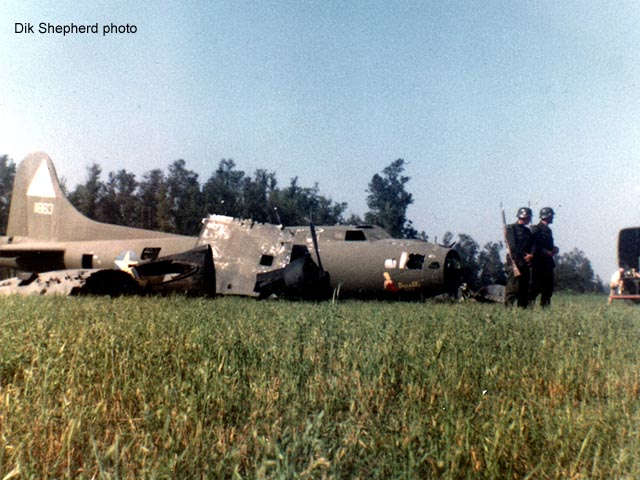
For those 12 O'Clock High fans, here is another trip down nostaligia lane. Dik also provided this image of the control tower used at Chino as part of the set dressing. Perhaps someone can correct me, but I think this may have been the actual tower used at Chino in its Cal Aero days. The FAA opened the existing tower at Chino later in the 1960s.
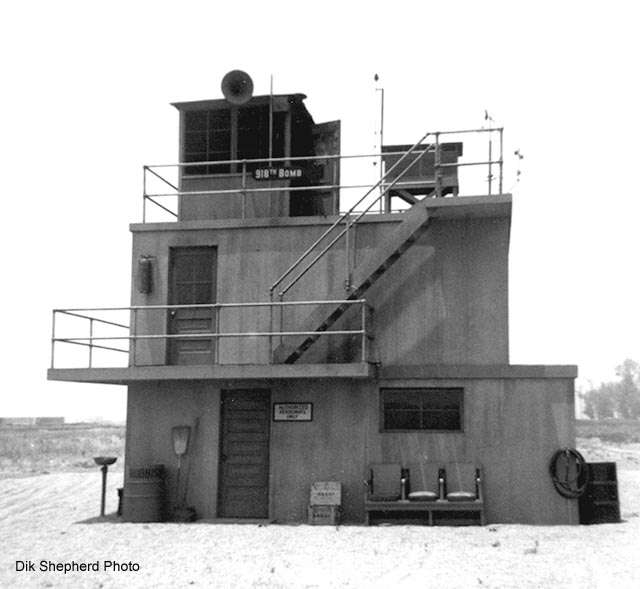
May 2004
- Widely reported is that the Lone Star Flight Museum's B-17G,44-85718 (N900RW) was repainted at the Ratheyon Service Center at Little Rock, Arkansas. According to an article in the March 2004 edition of Aviation International News, the museum began a working relationship with the service center when the museum sent some warbirds to a conference hosted by the service center in June 2003. After some negotiations, it was decided to turn over the refurbishment of N900RW, otherwise flying as Thunderbird, to the facility. Raytheon donated the use of the facility, and a Raytheon facility at Tampa, Florida, donated primer paint. Sherwin-Williams donated the topcoat of olive drab and neutral gray paint. Also performed at the service center was some interior work that included some new glass, some replica machine guns, and interior work tables.
- Finally a definitive word on the future of B-17D 40-3097, better known as The Swoose. This historic B-17D has been under the purported care of the National Air and Space Museum since 1948 and has yet to go on display (well, it's only been 56 years...give them a chance). Hopes were raised afresh in the past few years as the new annex facility has been completed at Dulles International Airport near Washington, D.C., and there was even an announcement at one point that at least the fuselage would be placed on display when the new facility was opened. No, it seems, it has not and will not. Thanks to some pointed questions by a concerned historian (not me), someone at the museum unofficially offered that there is little chance the B-17D will be put on display within the next five years because first they need a restoration building and then it "will take a bunch of years with all of the problems that bird has." Well, my comment is that perhaps NASM needs to push it up the priority list a bit and get busy on it. There are far less significant aircraft that seemed to have absorbed the museum's attention and resources. Perhaps they will get something done by the centennial of the aircraft's construction, that being 2040, only a short 36 years away. Maybe the Air Force Museum should confiscate the airplane. It deserves a better fate.
- B-17G 44-85734 that is nearing the end of a decade long rebirth (the terms "restoration" or even "reconstruction" don't do the effort justice) by Tom Reilly and crew at Kissimmee, Florida, was re-registered from N817BR to N390TH in February 2004. This represents the intent of the new owner of the airplane, the Liberty Foundation, to operate that airplane in 390th Bomb Group colors as the Liberty Belle when the airplane returns to the sky later this year. This is the third registration number carried by the airplane; it first flew as NL5111N with Pratt & Whitney from the 1940s through the 1960s, it then became N817BR for a few years during the current restoration process, and now becomes N390TH. Look through earlier months of B-17 News to read about some of the travails of this airplane as it truly is a Phoenix arising again. Thanks to Bill Lloyd for the information.
Also, with regards to the same airplane, this B-17G is reportedly to be managed by a Tulsa-based company that also manages B-25N 44-30823 (N1042B), so it is probable that this airplane will eventually be based at Tulsa. The management group apparently will arrange the FAA ride-program exemption for the B-17G as it already has for the B-25N.
-
Speaking of that ride-exemption program, there are many folks in the warbird community and the general aviation community closely watching a ill-considered FAA proposal that will eliminate all such ride programs, as well as other FAR Part 91 sightseeing flights. This is an important issue, one that concerns all those interested in general aviation or warbirds. See the EAA comments about this proposal here. I would suggest that everyone look at what these proposed regulations would do and comment before the again-extended deadline on June 20. Make your comments on the Department of Transportation's NPRM site here.
- The Jim Webb Restoration Center in Millington, Tennessee, is where the effort to restore the Memphis Belle is underway. The center is open for visitor to see the progress to bring the historic B-17F, 41-24485 to pristine display status for its new museum home in the Memphis area. The Memphis Belle Memorial Association announced in April that the facility will be open Wednesdays, Fridays, and Saturdays between 10 a.m. and 3 p.m. Those wanting to visit the center can get more information here. Thanks to Patrick Carry for this information.
- The registered owner of Aluminum Overcast, 44-85740 (N5017N), which, by the way is currently touring the west coast, changed from the Experimental Aircraft Association Foundation to just the Experimental Aircraft Association effective March 16, 2004. The change was probably just for insurance or other legal reasons. Not big news, but inquiring minds want to know. (Thanks to Bill Lloyd for the heads up.)
- After the note about Texas Raiders in the last update, and the fact that the FAA required Airworthiness Directive has yet to be complied with, contributor Patrick Carry determined that three other B-17s also have not had the AD completed, and these airplanes are also effectively grounded pending the completion of that work: 44-8543 (N3701G) marked as Chuckie, 44-83785 (N207EV) marked as Shady Lady, and 44-83563 (N9563Z), marked as Fuddy Duddy. Technically, this reduces the total number of actually airworthy B-17s to just nine.
- Not really news, but possibly of some interest is a photo kindly sent to me some months ago by Curt Hulslander. It is of the fuselage of B-17G 44-83316 sitting at Spearfish, South Dakota in 1968, after being transported overland from Chino, California.
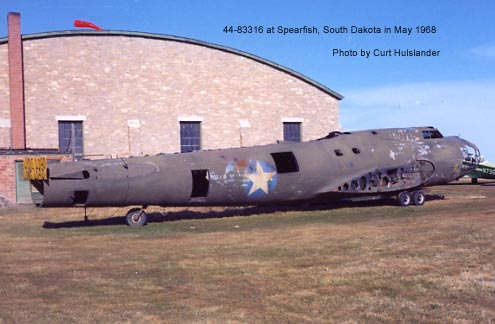
A close look at the photo shows a sign that reads "LONG LOAD WIDE LOAD" attached to the aft end of the fuselage. This B-17G had a bit of an unusual history. After it completed its USAF tour of duty in 1956 it was relegated to an unofficial base museum at Norton AFB in San Bernardino, California. In the early 1960s the USAF decided to take a dim view of such museums and some of the aircraft, including 44-83316, were put up for disposal. Tallmantz Aviation at nearby Orange County Airport had already made a deal with the USAF Museum to obtain a B-17G on a lease basis, and 44-83316 was earmarked. Other factions had plans, however, and it appears that the cockpit from this B-17G was stripped out to make a studio mock-up of a B-17 for use in the filming of the Twelve O'Clock High TV series between 1964 and 1966. Tallmantz eventually obtained another USAF B-17G (44-83525) and 44-83316 eventually was moved to Chino where at least the fuselage was used for scenes shot for the TV series, the exteriors of which were filmed at Chino. There is a photo of the fuselage of 44-83316 (taken by Jim Farmer) mounted on a stand to approximate the attitude of the B-17 if it were parked on its normal landing gear. Some of the fuselage skin was cut open for camera access and, reportedly, it was lit on fire a number of times during the several years it was a studio prop. After the filming ended in 1966, it was basically abandoned on a corner of the Chino Airport. Come 1968, however, and it was obtained by Arnold Kolb's Black Hills Aviation, based at Spearfish and one of the early B-17 air tanker operators. Kolb had earlier purchased the odd-ball but flyable B-17G, 44-85813 (N6694C) once used by the USAF and Wright Aeronautical as an engine test bed. The distinctive feature of N6694C was that it had a severe nose job, the cockpit having been moved rearward in the fuselage by several feet in a major modification undertaken by Boeing in 1946. Besides that, the normal bomber nose of N6694C was long gone. While in test programs, a fifth engine replaced the nose. Without a fifth engine installed, the nose was instead replaced by a bulbous ferry-flight nose cap that resulted in, frankly, one butt-ugly B-17.
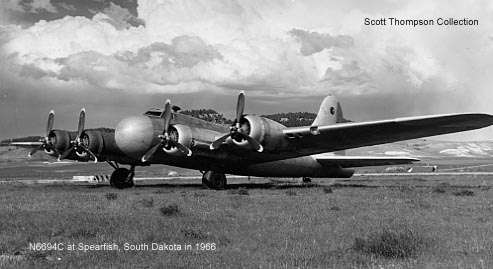
Kolb needed nose and cockpit structure to rebuild N6694C to a conventional configuration, items he obtained from the fuselage of 44-83316. N6694C did take to the skies again after its restorative nose job, but crashed at Bear Pen, North Carolina, in April 1980 and was effectively destroyed by a post-crash fire. The remains of 44-83316, now consisting primarily of several fuselage sections and a few other parts, made it into the collection of Kermit Weeks and was stored for many years in the Aero Trader facility at Ocotillo Wells in the southern California desert.
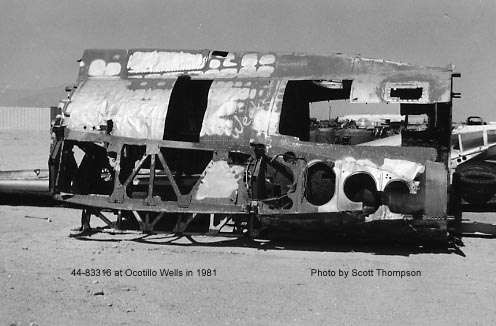
Meanwhile, the remains of N6694C were purchased by Tom Reilly and moved to his facility at Kissimmee where, coincidently, the only other five-engine test bed B-17G with the bad nose job (44-85734) was being restored. A few parts of N6694C may have actually made it into the restoration effort. In any event, Reilly eventually bought out Weeks' large stock of B-17 parts, so now he holds the fate of those three B-17s, the history of which are all inextricably tied together. By the way, the olive drab B-17 vertical stabilizer displayed by the Arizona Wing of the Confederate (err...Commemorative) Air Force in their Mesa, Arizona, hangar also came from orphan B-17G 44-83316. Thanks, Curt, for providing the photo to illustrate this little story.
March 2004
- The long awaited completion of the restoration of B-17G 44-85734 is almost upon us. This B-17G is now owned by the Liberty Foundation, headed by Don Brooks of Atlanta, Georgia. Under a very long term restoration by Tom Reilly and his shop at Kissimmee, Florida, this B-17 will fly as Liberty Belle, a 390th Bomb Group B-17G that operated from England with the Eighth Air Force. No dates are firm, but the announced expectation on the organization's website will tour this year. The best guess is that the airplane may be flying by summertime. The history behind this airframe is (almost) unique, it being one of three new B-17Gs that were extensively modified in 1945 and 1946 to incorporate an engine mount in the nose compartment. These airplanes were then used as test beds, and 44-85734 was operated by Pratt & Whitney between 1947 and 1967 to test a whole series of engines, both radial and turboprop. It was donated to a museum at Hartford, Connecticut, and went then was nearly destroyed by a tornado in 1979. It was then involved in a trade, coming to Tom Reilly in 1987. The airplane has required an incredible amount of work in three areas: restoration of the airplane after years of disuse; repair of the damage caused by the tornado; and significant rebuilding of the fuselage to return it to a conventional B-17G configuration and remove the extensive modifications that made it a test-bed. We await the unveiling of this 13th airworthy B-17G with anticipation.
- One up, two down. It should be acknowledged that the Museum of Flight's B-17F, 42-29782 (N17W) has probably made its last flight. It was flown back over from Renton, Washington, to Boeing Field earlier this year and placed into storage, pending the placement of the airplane on display inside the museum. Though the airplane is technically airworthy, it would seem that its flying days are over. It should also be noted that for all practical purposes, 44-83872 (N7227C), operated by the CAF as Texas Raiders is really in indefinite storage pending the eventual repair (we hope) of the wing structure so it can fly again. All it takes is money, and there isn't enough to get the airplane repaired. Thus, the scoreboard right now shows twelve B-17s operational or trying to be.
- Take a look at the American Aero Services website for photos of the work being done on B-17G 44-83785 (N93012). This airplane is having hail damage repaired, after which it will be repainted, once again gaining the Nine-O-Nine name and markings.
- Interesting bit of news from a gentleman named Bob Spriestersbach. He writes about a B-17 Encounter of a Mysterious Kind, circa Japan in 1973:
I was a US Navy parachute rigger on leave in Japan in the spring of 1973 traveling by train through mountains from Tachikawa to Mt. Fuji when we emerged from a tunnel and I looked out the window and saw a complete B-17, landing gear down- propellers intact- metal skin shining in the sun- and then we were in another tunnel. My companions never saw the plane and I never told them about it. I have no idea of our exact location except what I've told you, but the train tracks were lower in altitude than the plane and it was pointed towards the tracks as if it had landed under power and turned in order to take off again. My story, your people may already know, let me know if they do.
I've never heard anything about this before. A bit strange. Anybody have any information about this?
January 2004
- 'Maxum96' has offered some photos of the B-17 fuselage hanging in a bar named the State Armory located in Greeley, Colorado. This B-17 is as of yet unidentified but appears to have an intact ball turret installed. The fuselage extends from the nose compartment aft to the waist gun area, with a number of cutouts of the fuselage skin which would suggest use as a film prop. For those select few B-17-o-philes, this is quite interesting as this is yet another B-17 airframe the existence of which was generally unknown. Speculation that this airframe was used for the television series Twelve O'Clock High would appear to be unfounded as this airframe, 44-83316 is known and its whereabouts established. However, there were a number of movies that utilized a stage prop B-17 for interiors so that is probably the source of this airframe. Here are two photos of this as-yet unidentified B-17:
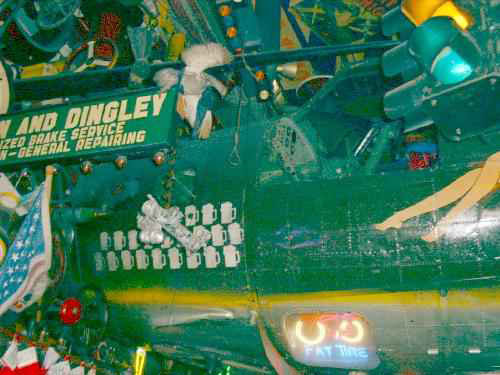
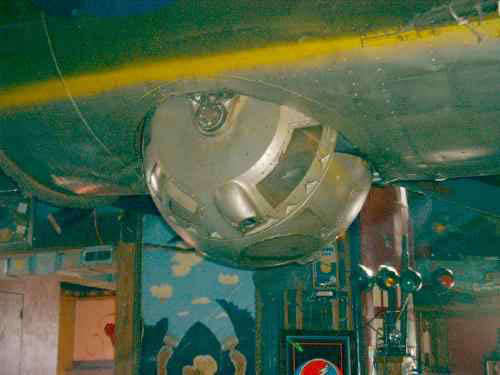
- We finally have had some photos of SB-17G 44-85583, operated by the Brazilian air force as FAB 5402, displayed at the Recife Air Base in Brazil. The FAB operated B-17s from 1951 until the late 1960s. The photos are by Roberto Bertazzo who has a short but informative article entitled Recife's Preserved Boeing B-17 at the Latin American Aviation Historical Society. Bertazzo notes that the B-17 is in "really good state of preservation."
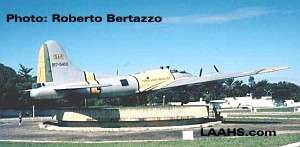
- An item from the November 2003 update has engendered further speculation about the actual identity of Bolivian B-17 CP-588, long mis-identifed as having been AAF s/n 44-6332, an airplane that was shot down over Austria in 1944. Looking back through source material, historian William Lloyd used a 1967 listing by another excellent source, John M. Davis, that had the Bolivian civil aviation authorities list the airplane as s/n 42-6332 which is the serial of a Boeing B-29, thus the basic Bolivian source is incorrect. Looking through aircraft record cards, it is quite probable that the misidentified B-17 is actually 42-5332, a B-17F that survived the war and was last noted at the War Assets Administration scrap yard at Ontario (actually, Chino), California, in late 1945. It can be speculated that the "5" was transposed to a "6," easy enough to do with hand-written records. This B-17 never was on the U.S. registry and instead showed up on the Bolivian civil registry beginning in 1951 as CB-88. It was later changed to CP-588 and crashed in Bolivia in 1963. With obscure or non-existent records and a half a century of time, it is doubtful a definitive identity of this airplane will ever be confirmed.
-
David Pope of Eston, Saskatchewan, passed along this photo of his restored Cletrac M2 towing B-17G 44-83546 (N3703G) at the Canada Remembers airshow at Saskatoon in August 2003. He notes that a B-17 crewmember told him he was "towing it the way it was meant to be towed," a point we can't disagree with.
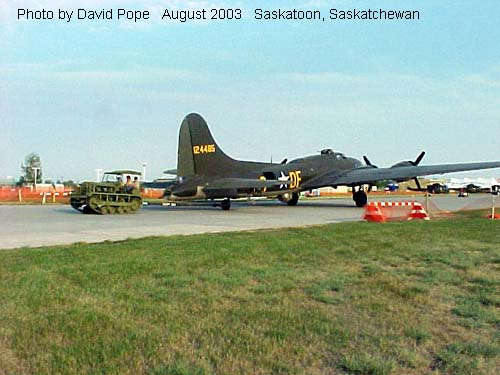
- Another update from information posted in November: the Collings Foundation will continue to tour only two airplanes, the B-24 and B-17G 44-83575 (N93012) after the B-17 comes out of heavy maintenance and repainting. It as been temporarily replaced on the current national tour by Collings B-25J 44-28932 (N3476G), flying as Tondelayo. Information courtesy of Ryan Keough of the Collings Foundation.
- There is an December 2nd article by Blake Fonteney published in the Memphis Commercial Appeal newspaper that talks about the efforts underway to restore and display the Memphis Belle, 41-24485. Besides the little name check this web site got in the article, of more interest is the ongoing threat of the USAF Museum to take the airplane away unless it gets better care. Some frustration by local advocates is expressed in trying to get the residents of Memphis to take an interest in the B-17F. The airplane, which is currently disassembled at Millington Municipal Airport undergoing yet another restoration effort, is to be placed in a as-yet-undetermined display facility within the next few years. The catch is that between $10 and $15 million is needed to fund the project, little of which has been raised. Some locals feel the USAF Museum threat is an idle one, and that the Memphis Belle, obviously belongs in Memphis. This is a very narrow view, however, for aviation preservationists, as the airplane is among the most famous surviving World War II airplanes, and it deserves a quality restoration and a climate-controlled display setting worthy of its history, whether a Memphis or elsewhere.
- Speaking of disappointing preservation efforts, the efforts by the National Air and Space Museum to display another very historic B-17, that being B-17D 40-3097, better known as The Swoose, has once again come up short. Despite the promise that this airplane would be reassembled (not restored) and displayed at the huge new Museum annex at Dulles airport, only the fuselage is reportedly on display. How long this situation is expected to continue is unknown, but it seems to me that the NASM has plenty of money to do intricate restorations of obscure German and Japanese warplanes, but can never seem to fund even the reassembly of the sole remaining B-17D that participated in the desperate early days of the Pacific War in late 1941 and early 1942. Given the continuing chaos over the display of the Enola Gay, it almost seems the NASM is afraid of offending the Japanese with yet another veteran of that conflict. This airplane deserves much better than what the NASM has done with it; perhaps the airplane should be taken away from them and given to the USAF Museum or some other institution that will take proper care of it. Granted, all it takes is money but the NASM has money; on what airplanes will it be spent?
B-17 News Archive
2018 B-17 News
2017 B-17 News
2016 B-17 News
2015 B-17 News
2014 B-17 News
2013 B-17 News
2012 B-17 News
2011 B-17 News
2010 B-17 News
2009 B-17 News
2008 B-17 News
2007 B-17 News
2006 B-17 News
2005 B-17 News
2004 B-17 News
2003 B-17 News
2002 B-17 News
1997-2001 B-17 News
Back to B-17 Information
Back to the Main Page